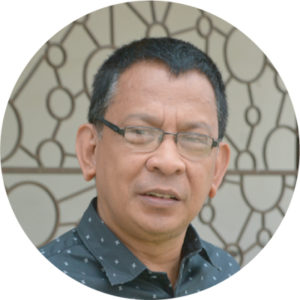National Institute of Molecular Biology and Biotechnology
University of the Philippines, Diliman
Home / Faculty Profiles / Wilberto D. Monotilla, Ph.D.
Wilberto D. Monotilla, Ph.D.
Associate Professor


PROFILE
President, Philippine Phycological Society, Inc. (2019 – 2019)
PhD Aquatic Bioscience (Phycology), Tokyo University of Marine Science and Technology, Japan
MS Aquatic Bioscience (Phycology), Tokyo University of Marine Science and Technology, Japan
BS Fisheries, University of the Philippines, Visayas, Philippines
CONTACT
- wdmonotilla@up.edu.ph
- 3F Central Office, NIMBB UPD
PUBLICATIONS
LABORATORY
- Aquatic Biotechnology Laboratory
Aquatic Biotechnology Laboratory
The Aquatic Biotechnology Laboratory (ABL) specializes in the cultivation of microalgal and seaweed cultures to study their industrial and commercial applications. From its establishment in 2009, ABL has grown from a single workbench laboratory to a laboratory sporting its own facilities.
Research Area
DNA Barcoding of different green algal species
The project generally intends to mine genes for the production of bioactive metabolites using NGS technology, particularly, whole genome sequencing of our microchlorophytes strains at collected from U.P. Diliman campus and isolate at least one compound with antiviral activity
Biobanking of green microalgae
This will serve as a pioneering database for the Philippine algal community that will give researchers access to data representing a large number of chlorophytes. It will use the three preservation methods as a means of maintaining cultures in the laboratory without the need for continuous sub-culturing if they will not be used for certain periods of time. The cultures can be sold to researchers, teachers and students which can give the Institute or University some income that can be channeled back to the laboratory for the continuous preservation and storage that will be self-sustaining.
Secondary ketocarotenoids from green microalgae
It is a source of metabolites such as the ketocarotenoid astaxanthin that can be of support to the health of the Filipino people as well as the pharmaceutical industry. Based on studies, this high-value carotenoid serves as a colorant, is used as a feed additive, and has commercial success in the aquaculture industry. It has been reported to be a potent anti-oxidant. In partnership with the industry, this research will evaluate the potential of 5 locally isolated microalgae with corresponding cultivation in the laboratory to maximize their ketocarotenoid astaxanthin production
Selected Publications
Dumilag, RV and WD Monotilla (2018). “Molecular diversity and biogeographof Philippine foliose Bangiales (Rhodophyta)”. J Appl Phycol. DOI 10.1007/s10811-017-1201-8. March 2018.
Dumilag, RD, Aguinaldo, ZA, Mintu, CB, Quinto, MP, Ame, EC, Andres, RC, Monotilla, WD, Yap, SL EP Cao, PG Vital and IKC Fontanilla (2017). “A review of the current taxonomic status of foliose Bangiales (Rhodophyta) in the Philippines.” Phytotaxa 312 (1): 047–059. July 2017.
de La pena, LD, NA Cabillon, EC Amar, DD Catedral, RC Usero, JP Faisan, Jr, JI Arboleda, WD Monotilla, AT Calpe, DDG Fernandez and CP Saloma (2017). “Mortality in Pond-cultured Penaeus vannamei in the Philippines Associated with Acute Hepatopancreatic Necrosis Disease (AHPND) and White Spot Syndrome Virus (WSSV)” Fish Pathology. Vol, 52, No.1, March 2017